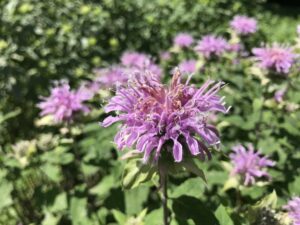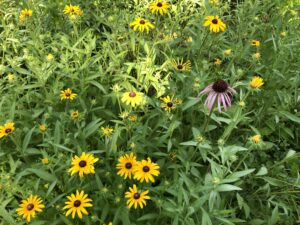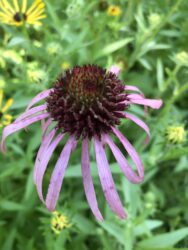By Bernheim

Deep within the Cedar Grove Wildlife Corridor of Bernheim Forest, there lies an inconspicuous farm field. It looks like any other that you’ve seen before – 15 acres of tidy, sharp edges, gentle slopes, and straight, stacked rows of green. In this case, the rows of green are winter wheat, a cover crop that is helping to suppress the germination of undesirable plants. Upon inspection, most would conclude that this field is like any other. The trees were cut, and the boulders and rocks were removed by some original owner, and for generations, the land was cultivated to grow things like tobacco, corn, and soybeans. This year the field may still look ordinary, but coming seasons will show an all-together different type of crop – native wildflowers and warm season grasses.

When Bernheim purchased the Cedar Grove Wildlife Corridor in 2018, plans were drawn to convert the production of this field to native prairie plants. These 15 acres, for many generations in the future, will provide a food source and habitat for pollinating insects, songbirds, and small and large mammals. Over the past year, Bernheim has been implementing these plans by preparing the site for prairie installation, including the installation of the winter wheat cover crop. By the summer of 2021, this field will be filled with workhorse native species such as brown-eyed Susan, purple coneflower, bergamot, and milkweed, and will be bustling with pollinator activity.

At Bernheim, we are often asked how visitors can make their own yards friendlier for insects, wildlife, and the environment on a larger scale. Drawing inspiration from (or even installing) pollinator habitat is a great way to bring a bit of Bernheim to your home.
Here’s how we create pollinator habitat at Bernheim, and how you can do it in your own backyard. Watch the video below for Natural Areas Manager, Evan Patrick’s home pollinator habitat in progress:
STEP 1: REMOVE UNDESIRABLE PLANTS
To increase the chance of successful installation, the seed bank must be cleared of non-native and undesirable species. Most yards are full of non-native cool season grasses and aggressive flowering plants that will take over the pollinator habitat. To ensure success of your installation, this step should begin at least one year, or depending on the severity of undesirable plant pressure, two years prior to installation. Removing these species can be accomplished by solarization (placing plastic over the site) or non-synthetic chemicals such as commercial grade vinegar. Regardless of the technique, the site needs to be treated in spring to eliminate cool season plants and in the summer to eliminate warm season plants. A third treatment between the spring and summer treatments is recommended as well.

STEP 2: PLANT SEEDS OR PLUGS FOR NATIVE PLANTS
Once the site is prepared, the native plants can be installed. Installing with seed can be more economical, but this method will take two growing seasons to fully develop the habitat, and plants will be randomly dispersed throughout the habitat. Native seed can be broadcast between May and late June or installed during dormancy in the winter. Based on the size of the site, the seed can be broadcast by hand, hopper, or with other implements such as conservation seeders and no-till drills that are specifically designed for native seed installation. These tools mimic the behavior of native plants, depositing the seed only one quarter of an inch or higher into the soil. This ensures greater germination rates.
Installing with plugs is more expensive, but this method will produce flowering plants in the first growing season and plugs can be installed in formal or semi-formal garden styles. Plugs can be installed in September to ensure healthy root development during the final months of the growing season. This promotes resilient, strong plants during the following spring and summer. While planting, soak each plug in water prior to planting, ensuring that each plant gets a large drink before going into the soil. Water the plugs for the next two weeks.
To keep your plants resilient over the coming growing seasons, and to reduce pressure from undesirable plants, place a 2-6-inch layer of mulch or woodchips around your plugs once they’re installed. Make sure to find mulch or woodchips that are natural and free from dyes and other chemicals. This layer will soak up water during irrigation or rain events, which will keep your plants watered during dryer times. It will also prevent seed from some undesirable plants from germinating.
STEP 3: BE PATIENT AND CAREFULLY KEEP CLEARING UNDESIRABLE SPECIES
Throughout the following year, the site can look unimpressive and sometimes even seem ill-fated. Exposed dirt and tiny plants will dominate when seed is sown. This early state is common while the seeds germinate and develop the deep root systems that nurture the plants and sequester larger amounts of carbon than their non-native, shallow rooted counterparts. It’s important during this first year to remove any non-native or undesirable species that remained in the seed bank. This can be difficult, as the native plants are developing root systems and will only produce rosettes, or basal growth, and not flowers. It is helpful to study the shapes and sizes of the rosettes of the plants installed in order to differentiate between native, desirable plants and non-native, undesirable plants. If the meadow is well managed, it is very likely that birds, insects, and mammals will use this newly rehabilitated habitat.

CAN I DO SOMETHING SMALLER THAT HELPS PROVIDE A HABITAT AT MY HOME?
The prairie restoration process is labor intensive and takes several months of preparation. The techniques described above are not always practical for homeowners on a small scale that are interested in creating pollinator habitat. Instead of depleting the seed bank and starting with seed, an old flower garden can be heavily mulched to reduce non-native and undesirable plants, and small, germinated plugs can be used for immediate impact. Hardy, workhorse species that are great for backyard pollinator gardens include brown and black-eyed Susan (Rudbeckia triloba, hirta respectively), purple coneflower (Echinacea purpurea), butterfly weed (Asclepias tuberosa), tickseed sunflower (Bidens polylepis), and lance-leaved coreopsis (Coreopsis lanceolata). Most of these plants can be purchased at big box hardware stores, but can also be purchased locally at nurseries such as Frank Otte Nursery and Garden Center, Dropseed Nursery, and Wallitsch Garden Center (Bernheim members even receive discounts at these and other nurseries).
WHERE CAN I SEE A PRAIRIE IN ACTION?
To catch a glimpse of the rabbits, birds, or bees taking up residence in established and rehabilitated habitat, visit one of the many prairies in Bernheim Arboretum and Research Forest when we open again. To see firsthand the steps of prairie restoration, keep a close eye on the Big Prairie as we increase biodiversity and flowering species over the coming growing seasons.

